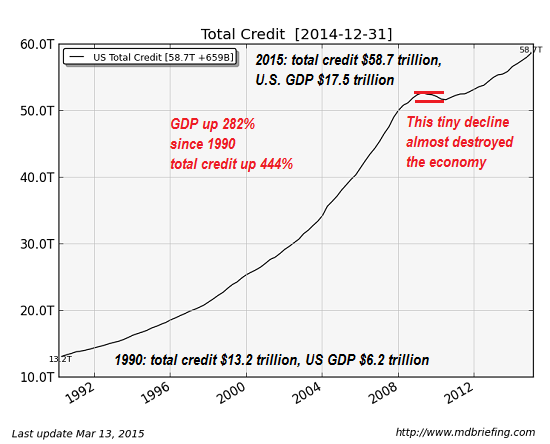Collapse Part 3: No Institutional Path to Contraction
One poorly understood source of collapse is the lack of pathways to contraction and a reduction of complexity and cost.
The only pathway that is clearly marked is the one to expansion–of production, debt, credit, government, income, benefits, costs and complexity: more agencies, more regulations, more committees, more staff, more of everything.
The path to less complexity, less debt, less production and a contraction of the entire system doesn’t exist in most institutions.
Many dismiss any talk of collapse as mere fear-mongering.
This is a legitimate issue to discuss, for if we focus exclusively on the lurid horrors of being killed by a shark in open water (for example) while ignoring the much higher risks of being killed by falling off a ladder at home, we have distorted the risks of accidental death and done a disservice to our understanding of various risks.
But collapse is not an event, it is a process. As a result, systemic collapse doesn’t lend itself to statistical calculations of probability. Processes are driven by dynamics, not odds.
So those dismissing any discussion of collapse as mere fear-mongering are doing a disservice to our understanding of processes–or lack thereof. One interesting feature of collapse is that it can result from either a choking over-abundance of complex, costly processes or a complete lack of essential processes, conceptually and practically.
Which brings us to the process that is lacking virtually everywhere–the process of contraction: shrinking the system, income, headcount, complexity and being productive with less of everything.
The corporate world offers many examples of what happens when the process of contraction and reducing complexity does not exist: companies buckle, fold and go bust.
The world’s corporate darling Apple experienced this precise death-spiral in 1996-1997 before the company’s board brought Steve Jobs back as CEO (So tentative was the board that Jobs was appointed “interim CEO”).
Apple had only one path: expansion. More fiefdoms, more staff, more product lines, more models, more sales, more profits. The reversal from profits to losses marooned the company, for there was no institutional history of a vast reduction in products, fixed costs and organizational complexity.
Not only was there no institutional history of downsizing, there was no conceptual or practical pathway from unprofitable bloat and institutional failure to a leaner, flatter more productive system.
Without an emergency infusion of cash from Microsoft and the appointment of a manager empowered to slash and burn fixed costs and re-set priorities and product lines, Apple would have collapsed.
The same can be said of the European Union. The bylaws of the EU (as I understand them) define the pathway of expanding the EU but not the pathway of forcibly shedding members. Member nations may elect to leave the EU of their own volition, but there is no mechanism in place for the EU to eject member nations such as Greece.
In other cases, systems are structured so any contraction leads to collapse.
This is the nature of our debt/leverage-based financial system: any contraction in debt, credit or inflation will bring the system down because the system is predicated on the permanent expansion of collateral to support more debt and the expansion of income to service debt.
If either collateral or income declines, the system implodes:
This is not an event, it is a process.
If debt and leverage expand while collateral and income decrease, the system becomes systemically more fragile and prone to destabilization. The financial system is dynamic and has multiple inputs; on its current setting, the system will become increasingly fragile. If alternative policies were put in place, it could become increasingly resilient.
Systems with no conceptual or practical pathway to contraction and reduced complexity/fixed costs are more at risk of collapse than systems with institutional pathways for successful reductions in debt, credit, income, fixed costs and complexity.
How many institutions have proven pathways for becoming smaller, leaner, and flatter in organizational structure? Very few, as the default setting for the past 60 years has been expansion and more of everything. Less of everything does not compute.
Regards,
Charles Hugh Smith
for The Daily Reckoning
P.S. Ever since my first summer job decades ago, I’ve been chasing financial security. Not win-the-lottery, Bill Gates riches (although it would be nice!), but simply a feeling of financial control. I want my financial worries to if not disappear at least be manageable and comprehensible.
And like most of you, the way I’ve moved toward my goal has always hinged not just on having a job but a career.
You don’t have to be a financial blogger to know that “having a job” and “having a career” do not mean the same thing today as they did when I first started swinging a hammer for a paycheck.
Even the basic concept “getting a job” has changed so radically that jobs–getting and keeping them, and the perceived lack of them–is the number one financial topic among friends, family and for that matter, complete strangers.
So I sat down and wrote this book: Get a Job, Build a Real Career and Defy a Bewildering Economy.
It details everything I’ve verified about employment and the economy, and lays out an action plan to get you employed.
I am proud of this book. It is the culmination of both my practical work experiences and my financial analysis, and it is a useful, practical, and clarifying read.




Comments: